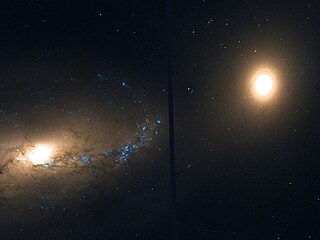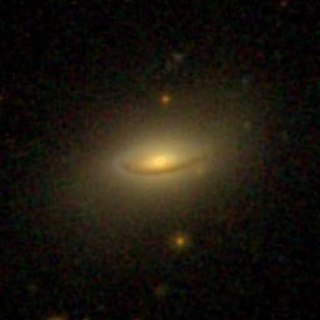
A quasar is an extremely luminous active galactic nucleus (AGN). It is sometimes known as a quasi-stellar object, abbreviated QSO. The emission from an AGN is powered by a supermassive black hole with a mass ranging from millions to tens of billions of solar masses, surrounded by a gaseous accretion disc. Gas in the disc falling towards the black hole heats up because of friction and releases energy in the form of electromagnetic radiation. The radiant energy of quasars is enormous; the most powerful quasars have luminosities thousands of times greater than that of a galaxy such as the Milky Way. Quasars are usually categorized as a subclass of the more general category of AGN. The redshifts of quasars are of cosmological origin.
An active galactic nucleus (AGN) is a compact region at the center of a galaxy that has a much-higher-than-normal luminosity over at least some portion of the electromagnetic spectrum with characteristics indicating that the luminosity is not produced by stars. Such excess, non-stellar emissions have been observed in the radio, microwave, infrared, optical, ultra-violet, X-ray and gamma ray wavebands. A galaxy hosting an AGN is called an active galaxy. The non-stellar radiation from an AGN is theorized to result from the accretion of matter by a supermassive black hole at the center of its host galaxy.

The Hubble Deep Field (HDF) is an image of a small region in the constellation Ursa Major, constructed from a series of observations by the Hubble Space Telescope. It covers an area about 2.6 arcminutes on a side, about one 24-millionth of the whole sky, which is equivalent in angular size to a tennis ball at a distance of 100 metres. The image was assembled from 342 separate exposures taken with the Space Telescope's Wide Field and Planetary Camera 2 over ten consecutive days between December 18 and 28, 1995.

In the fields of Big Bang theory and cosmology, reionization is the process that caused electrically neutral atoms in the universe to reionize after the lapse of the "dark ages".

Messier 77 (M77), also known as NGC 1068 or the Squid Galaxy, is a barred spiral galaxy in the constellation Cetus. It is about 47 million light-years (14 Mpc) away from Earth. Messier 77 was discovered by Pierre Méchain in 1780, who originally described it as a nebula. Méchain then communicated his discovery to Charles Messier, who subsequently listed the object in his catalog. Both Messier and William Herschel described this galaxy as a star cluster. Today, however, the object is known to be a galaxy.
In astronomical spectroscopy, the Gunn–Peterson trough is a feature of the spectra of quasars due to the presence of neutral hydrogen in the Intergalactic medium (IGM). The trough is characterized by suppression of electromagnetic emission from the quasar at wavelengths less than that of the Lyman-alpha line at the redshift of the emitted light. This effect was originally predicted in 1965 by James E. Gunn and Bruce Peterson.
A dark galaxy is a hypothesized galaxy with no stars. They received their name because they have no visible stars but may be detectable if they contain significant amounts of gas. Astronomers have long theorized the existence of dark galaxies, but there are no confirmed examples to date. Dark galaxies are distinct from intergalactic gas clouds caused by galactic tidal interactions, since these gas clouds do not contain dark matter, so they do not technically qualify as galaxies. Distinguishing between intergalactic gas clouds and galaxies is difficult; most candidate dark galaxies turn out to be tidal gas clouds. The best candidate dark galaxies to date include HI1225+01, AGC229385, and numerous gas clouds detected in studies of quasars.

NGC 3226 is a dwarf elliptical galaxy that is interacting with the spiral galaxy NGC 3227. The two galaxies are one of several examples of a spiral with a dwarf elliptical companion that are listed in the Atlas of Peculiar Galaxies. Both galaxies may be found in the constellation Leo. It is a member of the NGC 3227 Group of galaxies, which is a member of the Leo II Groups, a series of galaxies and galaxy clusters strung out from the right edge of the Virgo Supercluster.
Kenneth Irwin Kellermann is an American astronomer at the National Radio Astronomy Observatory. He is best known for his work on quasars. He won the Helen B. Warner Prize for Astronomy of the American Astronomical Society in 1971, and the Bruce Medal of the Astronomical Society of the Pacific in 2014.

APM 08279+5255 is a very distant, broad absorption line quasar located in the constellation Lynx. It is magnified and split into multiple images by the gravitational lensing effect of a foreground galaxy through which its light passes. It appears to be a giant elliptical galaxy with a supermassive black hole and associated accretion disk. It possesses large regions of hot dust and molecular gas, as well as regions with starburst activity.

GRS 1915+105 or V1487 Aquilae is an X-ray binary star system which features a regular star and a black hole. It was discovered on August 15, 1992 by the WATCH all-sky monitor aboard Granat. "GRS" stands for "GRANAT source", "1915" is the right ascension and "105" reflects the approximate declination. The near-infrared counterpart was confirmed by spectroscopic observations. The binary system lies 11,000 parsecs away in Aquila. GRS 1915+105 is the heaviest of the stellar black holes so far known in the Milky Way Galaxy, with 10 to 18 times the mass of the Sun. It is also a microquasar, and it appears that the black hole rotates at least 950 times per second, close to the maximum of 1,150 times per second, with a spin parameter value between 0.82 and 1.00.

NGC 4698 is a barred spiral galaxy located around 55 million light years away from Earth in the constellation of Virgo. It belongs to the Virgo Cluster of galaxies and is positioned near the northeastern edge of this assemblage. The morphological classification of NGC 4698 in the De Vaucouleurs system is SA(s)ab, which indicates a purely spiral structure with moderate to tightly wound arms. It is inclined to the line of sight from the Earth by an angle of 53° along a position angle of 170°.

NGC 708 is an elliptical galaxy located 240 million light-years away in the constellation Andromeda and was discovered by astronomer William Herschel on September 21, 1786. It is classified as a cD galaxy and is the brightest member of Abell 262. NGC 708 is a weak FR I radio galaxy and is also classified as a type 2 Seyfert galaxy.

NGC 4055 is an elliptical galaxy located 310 light-years away in the constellation Coma Berenices. It was discovered by astronomer William Herschel on April 27, 1785. It was rediscovered by John Herschel on April 29, 1832. It is listed both as NGC 4061 and NGC 4055. NGC 4055 is a member of the NGC 4065 Group and forms an interacting pair with its companion, NGC 4065 as evidenced by distortions in their optical isophotes.

NGC 4065 is an elliptical galaxy located 300 million light-years away in the constellation Coma Berenices. The galaxy was discovered by astronomer William Herschel on April 27, 1785. It was then rediscovered by John Herschel on April 29, 1832 and was listed as NGC 4057. NGC 4065 is the brightest member of the NGC 4065 Group.

NGC 4066 is an elliptical galaxy located 340 million light-years away in the constellation Coma Berenices. The galaxy was discovered by astronomer William Herschel on April 27, 1785. NGC 4066 is a member of the NGC 4065 Group.

NGC 4074 is a peculiar lenticular galaxy located 310 million light-years away in the constellation Coma Berenices. It was discovered by astronomer William Herschel on April 27, 1785 and is a member of the NGC 4065 Group.














